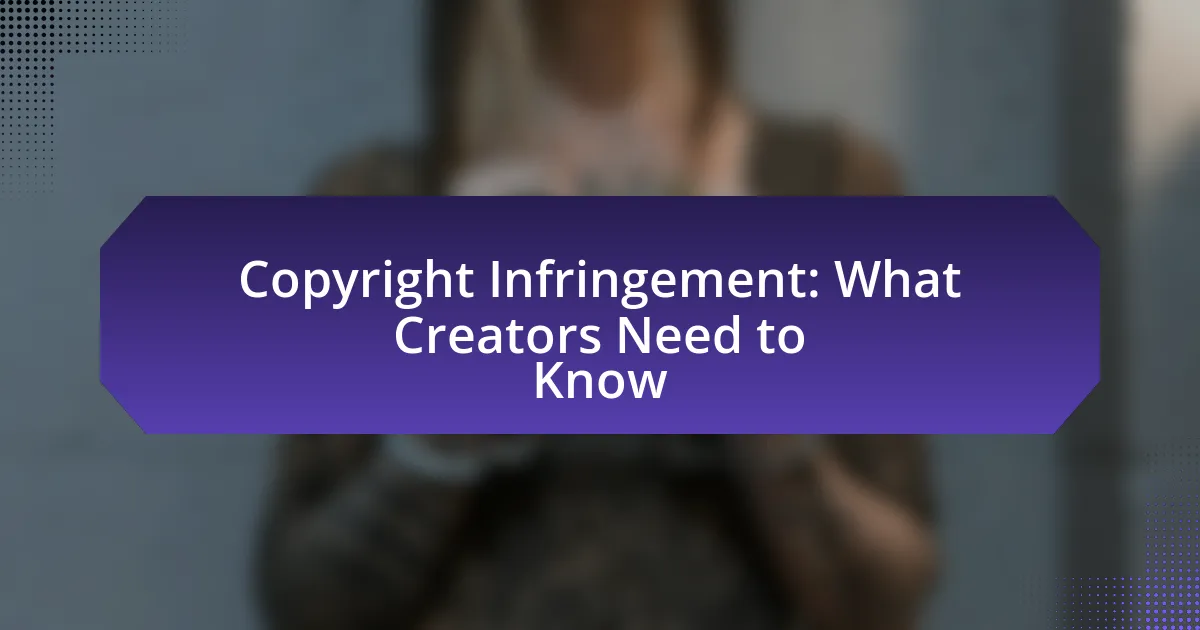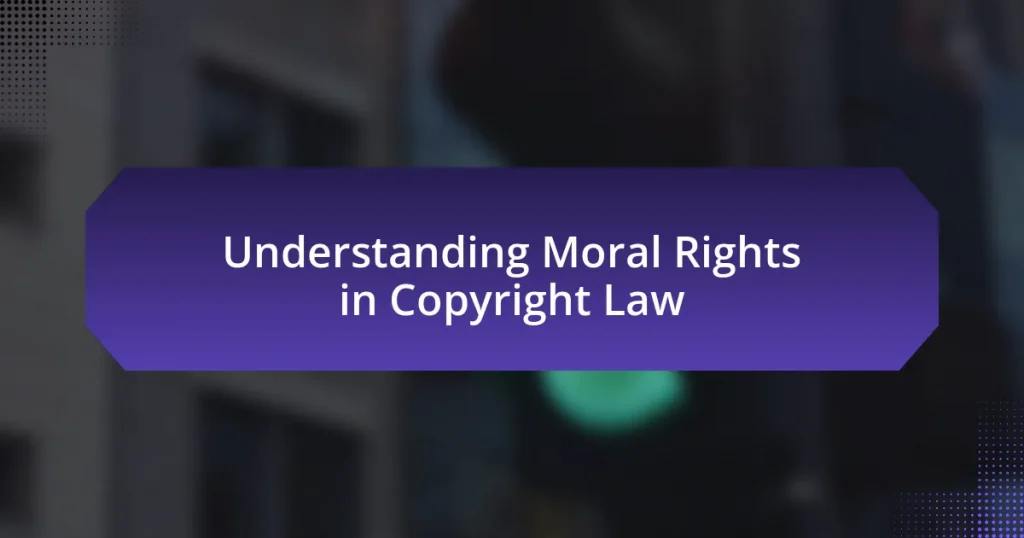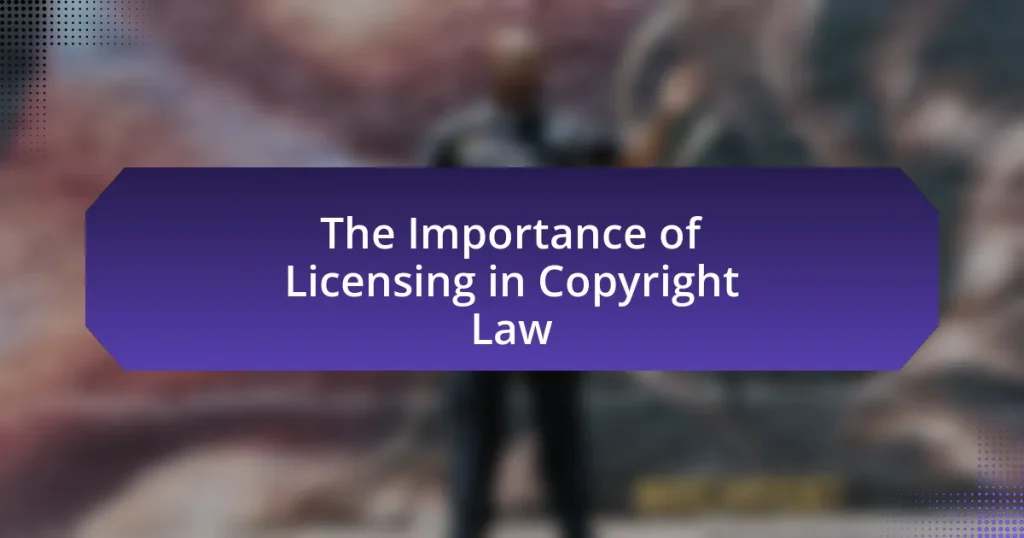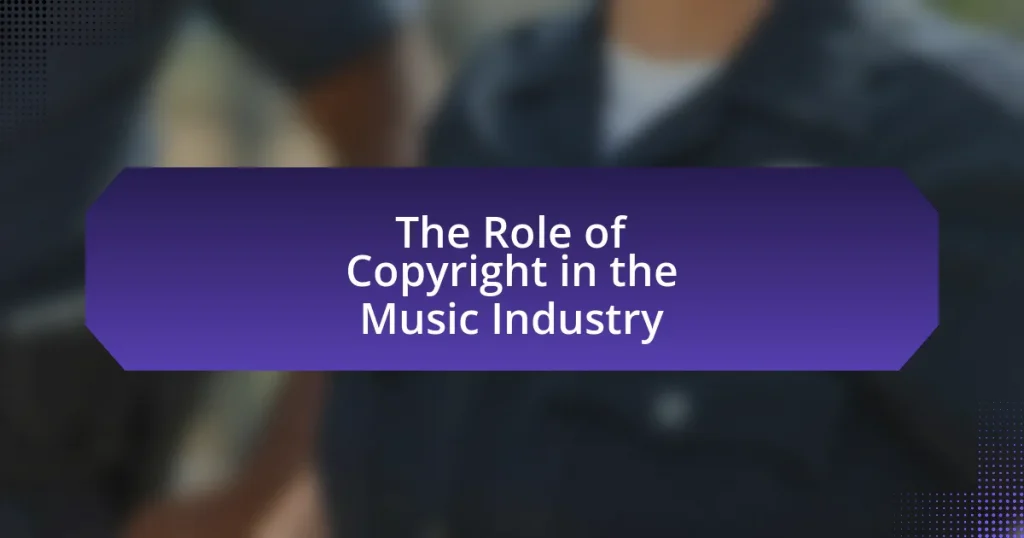Copyright infringement refers to the unauthorized use of copyrighted works, violating the exclusive rights of the copyright holder as established by the U.S. Copyright Act of 1976. This article outlines the definition of copyright infringement, its legal implications, and the differences between copyright and other types of infringement. It emphasizes the importance of understanding copyright laws for creators to protect their intellectual property, avoid legal disputes, and maintain their reputation. Additionally, the article discusses common forms of infringement, the risks creators face, and best practices for safeguarding their works, including registration, licensing, and monitoring for unauthorized use.
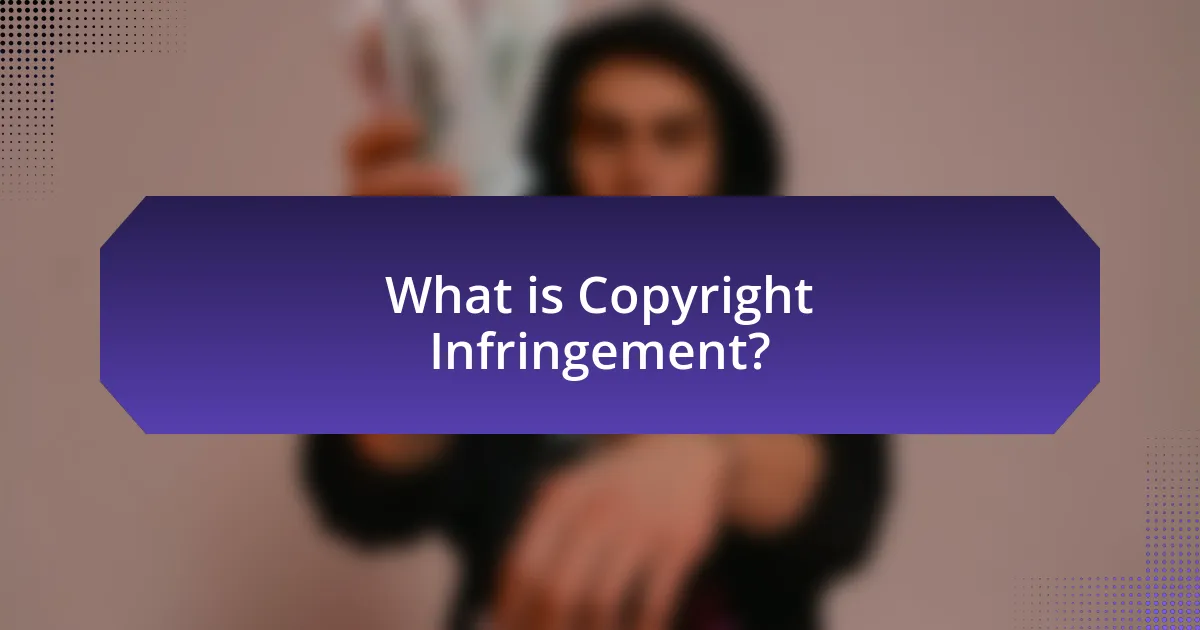
What is Copyright Infringement?
Copyright infringement occurs when an individual or entity uses a copyrighted work without permission from the copyright holder. This unauthorized use can include reproduction, distribution, performance, or display of the work, and it violates the exclusive rights granted to the copyright owner under the Copyright Act of 1976 in the United States. Legal consequences for copyright infringement can include monetary damages and injunctions against further use of the work.
How is Copyright Infringement defined?
Copyright infringement is defined as the unauthorized use of copyrighted material in a way that violates the rights of the copyright holder. This includes reproducing, distributing, performing, or displaying the work without permission. The U.S. Copyright Act of 1976 establishes these rights, and infringement can lead to legal consequences, including monetary damages and injunctions against further use.
What are the legal implications of Copyright Infringement?
Copyright infringement can lead to significant legal consequences, including civil lawsuits, statutory damages, and potential criminal penalties. When a copyright owner proves infringement, they may seek remedies such as monetary compensation for damages, which can range from actual damages to statutory damages of up to $150,000 per work infringed, as outlined in the Copyright Act of 1976. Additionally, infringers may face injunctions to prevent further unauthorized use of the copyrighted material. In severe cases, willful infringement can result in criminal charges, leading to fines and imprisonment. These legal implications underscore the importance of respecting copyright laws to avoid substantial financial and legal repercussions.
How does Copyright Infringement differ from other types of infringement?
Copyright infringement specifically involves the unauthorized use of a creator’s original works, such as literature, music, and art, while other types of infringement, like trademark or patent infringement, pertain to the misuse of brand identifiers or inventions. Copyright law protects the expression of ideas, not the ideas themselves, which distinguishes it from patent law that protects inventions and trademark law that safeguards brand identity. For instance, copyright infringement can occur when someone reproduces a song without permission, whereas patent infringement would involve making or selling a patented invention without authorization. This distinction is crucial as it defines the legal frameworks and protections applicable to different types of intellectual property.
Why is understanding Copyright Infringement important for creators?
Understanding copyright infringement is crucial for creators because it protects their intellectual property rights and ensures they receive recognition and compensation for their work. Creators who grasp the nuances of copyright law can avoid unintentional violations that may lead to legal disputes, financial losses, or damage to their reputation. For instance, the U.S. Copyright Office reported that copyright infringement can result in statutory damages ranging from $750 to $30,000 per work, emphasizing the financial stakes involved. By understanding copyright infringement, creators can safeguard their creations, navigate licensing agreements effectively, and foster a culture of respect for artistic and intellectual contributions.
What risks do creators face if they ignore Copyright Infringement?
Creators face significant legal and financial risks if they ignore copyright infringement. Ignoring copyright infringement can lead to lawsuits, resulting in costly legal fees and potential damages that can reach up to $150,000 per infringement under U.S. law. Additionally, creators may face loss of revenue from their original works, as unauthorized use can diminish their market value. Furthermore, reputational damage can occur, as being associated with copyright violations can harm a creator’s credibility and relationships within their industry.
How can knowledge of Copyright Infringement protect a creator’s work?
Knowledge of copyright infringement enables creators to safeguard their original works by understanding their legal rights and the mechanisms available for enforcement. By being aware of copyright laws, creators can identify unauthorized use of their work, which allows them to take appropriate legal action, such as sending cease-and-desist letters or filing lawsuits. For instance, the U.S. Copyright Act provides creators with exclusive rights to reproduce, distribute, and display their works, and understanding these rights empowers creators to protect their intellectual property effectively. Furthermore, statistics show that creators who actively monitor and enforce their copyright are more likely to deter infringement and maintain control over their work, thereby enhancing their ability to monetize their creations.
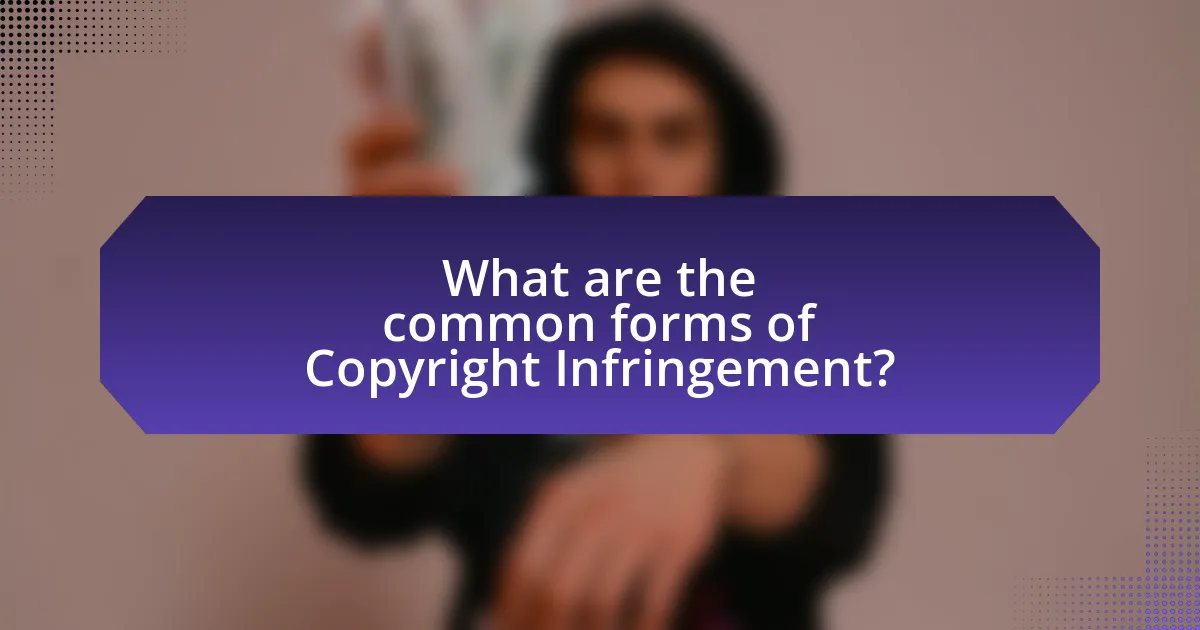
What are the common forms of Copyright Infringement?
Common forms of copyright infringement include unauthorized reproduction, distribution, performance, and display of copyrighted works. Unauthorized reproduction occurs when someone copies a work without permission, such as photocopying a book or downloading music illegally. Distribution infringement happens when copyrighted material is shared without consent, like uploading a movie to a torrent site. Performance infringement involves presenting a copyrighted work publicly without authorization, such as playing a song at an event without a license. Display infringement occurs when someone shows a copyrighted work, like artwork or photographs, without permission. These actions violate the exclusive rights granted to copyright holders under the Copyright Act of 1976 in the United States, which protects original works of authorship.
What types of works are typically subject to Copyright Infringement?
Copyright infringement typically applies to original works of authorship, including literary works, musical compositions, visual arts, and audiovisual works. These categories encompass books, songs, paintings, films, and software, all of which are protected under copyright law. For instance, the U.S. Copyright Act of 1976 explicitly recognizes these types of works as eligible for copyright protection, thereby establishing the legal framework for addressing infringement.
How does Copyright Infringement occur in digital media?
Copyright infringement in digital media occurs when an individual or entity uses copyrighted material without permission from the copyright holder. This can happen through unauthorized reproduction, distribution, or display of digital content such as music, videos, images, or software. For instance, sharing a copyrighted song on a file-sharing platform without the artist’s consent constitutes infringement. According to the U.S. Copyright Office, copyright infringement can lead to legal consequences, including monetary damages and injunctions against further use.
What are examples of Copyright Infringement in literature and art?
Examples of copyright infringement in literature and art include unauthorized reproduction of books, where a publisher prints and sells copies of a novel without the author’s permission. Another example is the use of a painting in a commercial advertisement without the artist’s consent, which violates the artist’s exclusive rights. Additionally, fan fiction that incorporates characters and settings from a copyrighted book series without permission constitutes copyright infringement. These instances demonstrate the violation of the creator’s rights to control the use of their original works, as established by copyright law.
How can creators identify Copyright Infringement?
Creators can identify copyright infringement by monitoring the use of their original works across various platforms and utilizing digital tools designed for copyright detection. They can employ services like Google Alerts, which notify them when their content appears online, or specialized software that scans the internet for unauthorized reproductions. Additionally, creators should familiarize themselves with copyright laws and guidelines to understand their rights and the specific criteria that constitute infringement, such as unauthorized reproduction, distribution, or display of their work. This proactive approach helps creators protect their intellectual property effectively.
What signs indicate that Copyright Infringement may be occurring?
Signs that copyright infringement may be occurring include unauthorized use of copyrighted material, such as images, music, or text, without permission from the copyright holder. Additionally, if a work is being distributed or sold without proper licensing, it indicates potential infringement. Instances where similar works appear in different locations or platforms, especially if they closely resemble the original, can also signal infringement. Furthermore, receiving complaints or notices from copyright holders about unauthorized use can serve as a clear indication of infringement. These signs are supported by legal frameworks, such as the U.S. Copyright Act, which outlines the rights of copyright holders and the consequences of infringement.
How can creators monitor their work for potential infringement?
Creators can monitor their work for potential infringement by utilizing digital tools and services designed for copyright tracking. These tools, such as Google Alerts, can notify creators when their work appears online, while platforms like Copyscape and DMCA.com help identify unauthorized use of content. Additionally, creators can perform regular manual searches on social media and websites to check for unauthorized reproductions. According to a study by the International Intellectual Property Alliance, proactive monitoring can significantly reduce instances of copyright infringement, highlighting the importance of vigilance in protecting creative works.
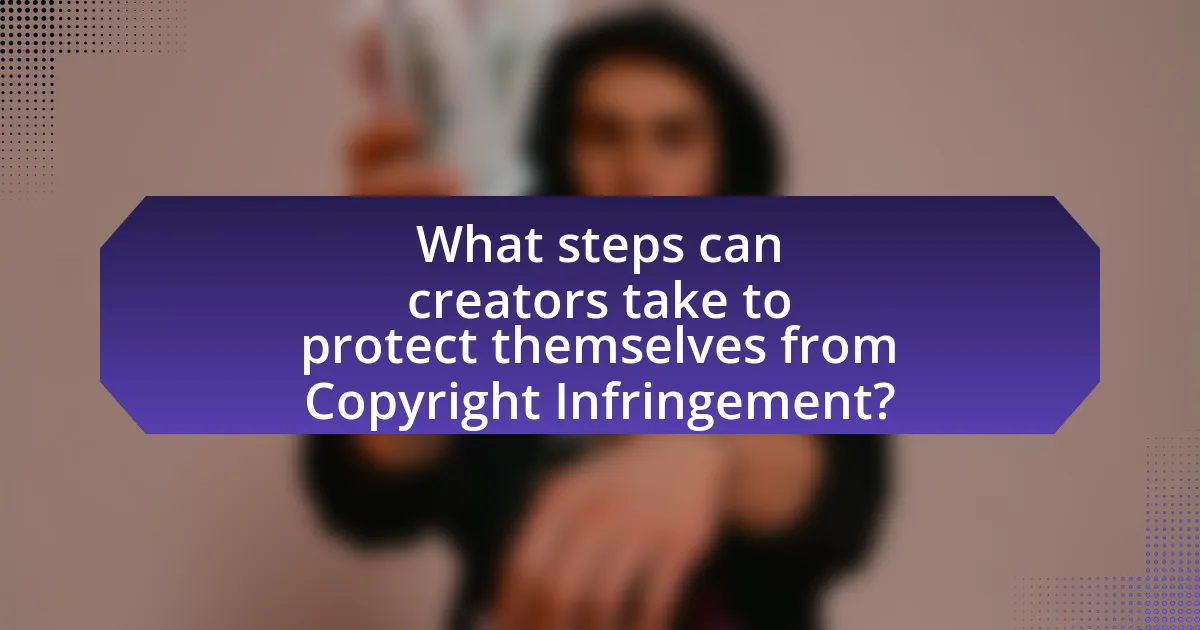
What steps can creators take to protect themselves from Copyright Infringement?
Creators can protect themselves from copyright infringement by registering their works with the U.S. Copyright Office, which provides legal evidence of ownership and the ability to sue for damages. Additionally, they should include copyright notices on their works, which inform others of their rights and discourage unauthorized use. Creators can also utilize digital rights management (DRM) tools to control access to their content and monitor its distribution. Furthermore, they should educate themselves about fair use and licensing agreements to understand how their work can be legally used by others. These steps are essential as they establish legal protections and clarify the creator’s rights, reducing the risk of infringement.
What legal measures can be taken to safeguard creative works?
Legal measures to safeguard creative works include copyright registration, trademark protection, and the use of non-disclosure agreements (NDAs). Copyright registration provides legal recognition and the ability to enforce rights against unauthorized use, as established by the U.S. Copyright Office, which allows creators to sue for statutory damages and attorney fees. Trademark protection helps secure brand identity and prevents others from using similar marks that could confuse consumers. NDAs protect sensitive information and creative ideas from being disclosed or used without permission. These measures collectively enhance the legal framework that supports and protects the rights of creators in their original works.
How does registering a copyright help in protecting a creator’s work?
Registering a copyright provides legal recognition and protection for a creator’s work, making it easier to enforce rights against unauthorized use. This registration establishes a public record of the creator’s ownership, which can deter infringement and strengthen legal claims in court. According to the U.S. Copyright Office, registered works are eligible for statutory damages and attorney’s fees in infringement cases, enhancing the creator’s ability to seek compensation.
What role do licenses play in preventing Copyright Infringement?
Licenses play a crucial role in preventing copyright infringement by granting permission to use copyrighted material under specified conditions. By obtaining a license, individuals or organizations can legally utilize creative works, thereby reducing the risk of unauthorized use that constitutes infringement. For example, the U.S. Copyright Act allows copyright holders to issue licenses that define the scope of use, such as duration, territory, and purpose, which helps to clarify rights and responsibilities. This legal framework not only protects the interests of creators but also provides users with a clear understanding of how they can engage with the work without violating copyright laws.
What best practices should creators follow to avoid Copyright Infringement?
Creators should follow best practices such as obtaining permission for using copyrighted material, utilizing public domain or Creative Commons licensed content, and ensuring original creation of their work to avoid copyright infringement. Obtaining permission involves contacting the copyright holder and securing a license, which is essential for legal use. Utilizing public domain works, which are free from copyright restrictions, or Creative Commons licensed content, which allows specific uses under certain conditions, can significantly reduce the risk of infringement. Additionally, creating original content ensures that creators own the rights to their work, thereby eliminating the possibility of infringing on others’ copyrights. These practices are supported by copyright law, which protects original works and outlines the consequences of infringement, including potential legal action and financial penalties.
How can creators ensure they are using others’ works legally?
Creators can ensure they are using others’ works legally by obtaining permission or licenses for the use of copyrighted material. This involves identifying the copyright holder and requesting explicit consent to use their work, which can often be done through licensing agreements. Additionally, creators should familiarize themselves with fair use provisions, which allow limited use of copyrighted material without permission under specific circumstances, such as commentary, criticism, or educational purposes. Understanding the scope of these provisions is crucial, as misuse can lead to legal repercussions. Furthermore, utilizing works that are in the public domain or available under Creative Commons licenses can provide a legal avenue for using others’ works without infringing copyright.
What resources are available for creators to learn about Copyright laws?
Creators can learn about copyright laws through various resources, including government websites, online courses, and legal guides. The U.S. Copyright Office provides comprehensive information on copyright registration, laws, and FAQs, making it a primary resource for creators. Additionally, platforms like Coursera and Udemy offer courses specifically focused on copyright law, often taught by legal professionals. Legal guides, such as “Copyright Law for Dummies,” provide accessible explanations of complex legal concepts. These resources collectively equip creators with the knowledge necessary to navigate copyright laws effectively.
What should creators do if they suspect Copyright Infringement?
Creators should promptly document the suspected copyright infringement by gathering evidence such as screenshots, URLs, and timestamps. This documentation serves as a crucial record to support their claim. Next, creators should review the terms of service of the platform where the infringement occurred, as many platforms have specific procedures for reporting copyright violations. Following this, creators can file a formal complaint or a Digital Millennium Copyright Act (DMCA) takedown notice with the platform or the infringing party, clearly outlining the infringement and providing the collected evidence. It is also advisable for creators to consult with a legal professional specializing in intellectual property to explore further legal options if necessary.
How can creators effectively respond to instances of Copyright Infringement?
Creators can effectively respond to instances of copyright infringement by promptly documenting the infringement, contacting the infringer, and potentially filing a Digital Millennium Copyright Act (DMCA) takedown notice. Documenting the infringement involves collecting evidence such as screenshots, URLs, and timestamps to establish the unauthorized use of their work. Contacting the infringer directly can sometimes resolve the issue amicably, as they may not be aware of the infringement. If these steps do not yield results, filing a DMCA takedown notice with the hosting platform can lead to the removal of the infringing content, as platforms are legally required to act on valid notices. According to the U.S. Copyright Office, the DMCA provides a streamlined process for copyright holders to protect their works online.
What are the steps to take when filing a complaint for Copyright Infringement?
To file a complaint for copyright infringement, follow these steps: First, gather evidence of the infringement, including the original work and proof of ownership. Next, identify the infringing party and their contact information. Then, draft a formal complaint letter detailing the infringement, including specific information about the copyrighted work and how it has been used without permission. After that, send the complaint to the infringing party, and if necessary, file a Digital Millennium Copyright Act (DMCA) takedown notice with the relevant platform or service provider hosting the infringing content. Finally, if the issue is not resolved, consider seeking legal advice or pursuing litigation. These steps are supported by the provisions of the Copyright Act, which outlines the rights of copyright holders and the procedures for addressing infringement.
